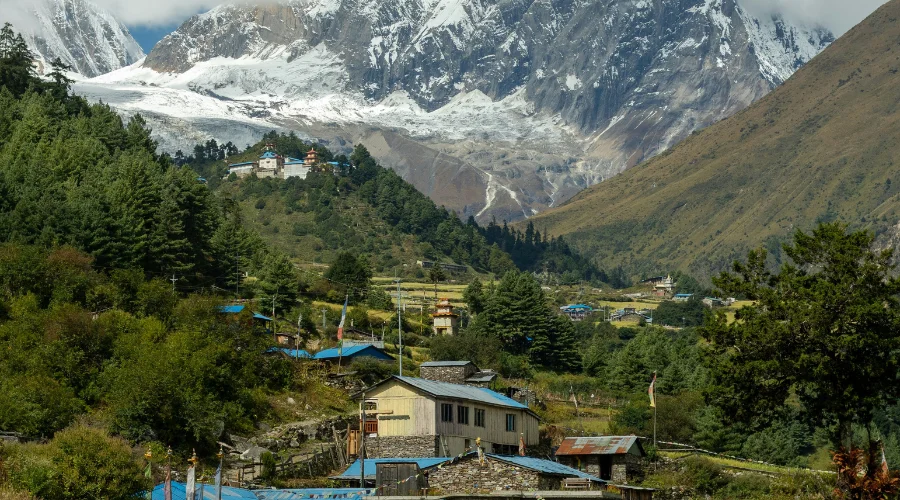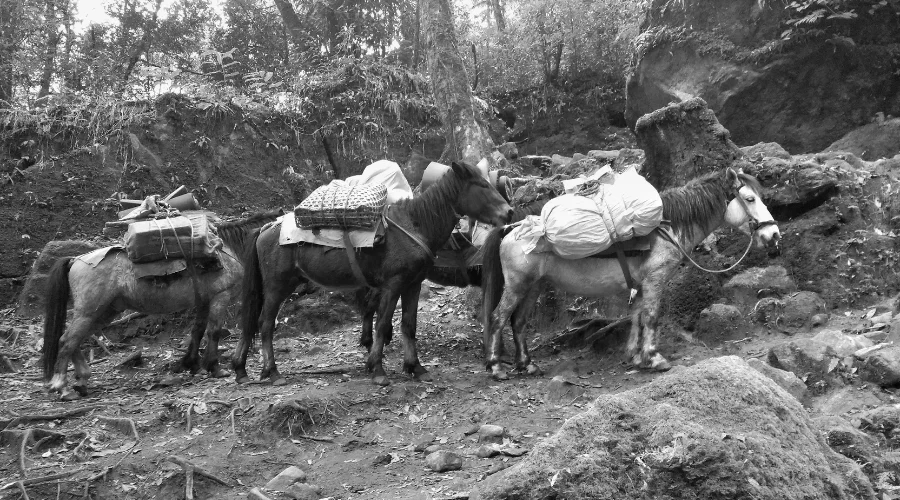Travelers consider Manaslu Trek as one of the outstanding trekking experiences in Nepal because of both its adventure and its stunning beauty. You will walk around the eighth-highest peak and mountain in the world called Mount Manaslu which reaches 8163 meters high.
Nice new trails and a welcoming traditional village society with valuable cultural heritage exist throughout this trek. This trek in the Manaslu region operates under much less crowds than Everest and Annapurna, therefore offering a peaceful and distinct travelling experience.
During the Manaslu Circuit Trek, you will cross high-suspension bridges along with traditional villages bearing Tibetan culture, fast-moving rivers, and dense forests. The trail passes through these areas. Passing through the daring Larke Pass at 5,106 meters delivers an additional thrill to this trek.
Trekkers must obtain special permits because the restricted area requires a mandatory guide for access. Those seeking authentic Himalayan adventures should choose the Manaslu Circuit Trek since it avoids popular tourist routes.
Overall Difficulty of Manaslu Circuit Trek
The Manaslu Circuit Trek difficulty falls into the middle group of hiking complexity between easy and challenging.
A good mix of physical fitness alongside trekking experience combined with mental readiness are required for this expedition although it is not extremely difficult to accomplish.
Travellers should expect differences between long daily walks and steep elevations as well as elevated heights and wild landscapes during this trek.
The duration of the Manaslu Trek spans fourteen to eighteen days based on trekking plans because most participants walk between six to eight hours every day.
The major Manaslu Circuit Trek Difficulty comes from the elevated terrain, particularly at Larke Pass, where its 5,106-meter height presents problems for individuals who lack experience with thin air conditions.
Trekkers in this path find a combination of wild terrain, stone stairs, and private forest trails. Due to its lack of development, the area provides fewer resources than where trekking is more common.
Through appropriate preparations for fitness levels, the Manaslu Trek remains accessible to the most passionate trekkers, who also receive guidance from local personnel.
Altitude and Acclimatization Challenges
Being at a high altitude remains the main obstacle during the Manaslu Trek. The journey begins by descending from 700 meters at Soti Khola before ascending beyond 5000 meters at Larke Pass (5,106 meters).
Your breathing becomes more difficult because of reduced oxygen levels, which also make the walk increasingly exhausting with greater altitude.
Elevation changes too fast at high altitudes which leads to Altitude Sickness that medical professionals refer to as Acute Mountain Sickness (AMS) if you do not acclimatize properly.
Proper acclimatization days with a slow-paced approach are essential to prevent altitude problems when travelling. Most trekking plans incorporate built-in rest periods in Sama Gaun (3,530 meters) and Samdo (3,860 meters) to let the body adapt to height surges.
During these days, trekkers need to climb to nearby viewpoints before descending to spend the night at lower elevations to achieve proper acclimatization.
The main signs of altitude sickness consist of headaches alongside nausea, lack of appetite, and dizziness. You must rest immediately and notify your guide when any signs of these symptoms show themselves.
Trekkers typically navigate altitude levels successfully when they receive proper care and follow an appropriate itinerary plan while drinking adequate water.
Duration of Manaslu Circuit Trek
The total duration of Manaslu Circuit Trek is around14 to 18 days to finish based on your travel speed as well as your scheduled stops and rest days for acclimatizing to higher elevation. Through the entire trek a person will walk 177 kilometers (110 miles).
The daily path requires six to eight hours of walking, which leads to travelling 10 to 15 kilometres each day. From Soti Khola or Machha Khola, the trek leads to Dharapani as it crosses multiple villages and passes through different forested areas and mountain paths.

The trek should not be rushed because doing so increases your chance of suffering from altitude sickness, which can lead to fatigue symptoms.
Physical Fitness Requirements for Manaslu Trek
Physical fitness is an essential requirement for completing the Manaslu Trek since it is challenging for most participants.
The trek requires walkers who feel at ease with multiple burdensome activities which include extended foot journeys along rocky landscape and variable slope conditions.
The trek leads to multiple days of uninterrupted walking across conditions of steep and challenging terrain requiring strong leg muscles and excellent stamina.
Previous trekking adventures provide benefits for this journey, but novices who prepare beforehand will succeed at this trekking adventure.
Before trekking start you should exercise your heart through activities such as jogging or hiking or swimming or cycling for at least several weeks to develop endurance.
Being mentally strong stands out as essential because the trek will isolate you from contemporary amenities and possibly present demanding conditions including extreme weather and challenging altitudes together with minimal facilities.
Manaslu Trail Conditions and Terrain
Different Manaslu Circuit Trek difficulty trail conditions exist throughout the Manaslu region which include flat paths together with rocky climbs followed by forested paths.
Lower parts of the trek lead hikers through terraced farmlands where they must cross suspension bridges and hike along narrow cliffside trails. The path gains ruggedness along with colder temperatures while becoming rockier as elevation increases.
The snow-covered trails become especially challenging close to the highest region of Larke Pass. The lower paths become slippery from mud during rainy months yet the snow and ice conditions on high elevation trails increase during winter months.
Weather and Seasonal Impacts
The Manaslu Circuit Trek difficulties directly correlate with the weather conditions present during the trek. It is ideal to undertake the Manaslu Trek during the spring months of March to May and the autumn period running from September to November.
Visitors can enjoy good mountain scenery alongside suitable weather conditions when they travel in the spring and fall months. High elevation locations experience cold nights regardless of the overall best season of the year.
The trails become extremely slippery and muddy during the monsoon season extending from June through August. Despite favorable conditions in spring (March to May) and autumn (September to November) landslides and leeches remain frequent while the mountain views are commonly blocked by clouds.
The winter months from December through February bring freezing temperatures linked with snow accumulations, which can lead to closures of the Larke Pass because of heavy snow.
Safety, comfort, and satisfaction levels during the trek highly depend on choosing the correct seasonal timing.
Manaslu Circuit Permits and Restricted Area Regulations
Travelling through the Manaslu region demands official permits since this territory functions as a restricted zone. For this trek, you need to use a licensed guide as the route allows access only to groups containing two or more people.
The Manaslu Circuit Trek permits are Manaslu Restricted Area Permit (RAP) that determines fee levels based on the restricted area stay duration.
- Manaslu Restricted Area Permit (RAP): Required from Jagat to Sama Gaun. The cost of the permit depends on your total duration in the restricted area.
- Manaslu Conservation Area Permit (MCAP) and ACAP: The Annapurna Conservation Area Permit (ACAP) is a necessary requirement since the trek terminates in the Annapurna region.
- A Tsum Valley Permit becomes necessary only when your trek includes this valley.
Traversing the Manaslu Circuit requires advance permit acquisition through your designated trekking agency before starting the journey. Lack of proper permits may result in fines, together with denial of access to certain areas.
Availability of Tea Houses and Accommodation
Trekkers can access standard tea house facilities throughout the Manaslu Trail. Most villages throughout the area operate basic family-run lodges that supply rooms with beds and blankets as well as pillows.
Accommodation at the Manaslu Trek consists mainly of basic twin-sharing rooms that share bathrooms and have restricted hot water availability.
Tea house facilities have become more rustic in the areas surrounding Sama Gaun and Dharmashala, owing to the challenging supply delivery and distant location conditions.
Manaslu tea houses offer food service which includes dishes such as dal bhat combined with noodles and soups and tea beverages.
Sleep in these tea houses to enjoy both a comfortable setting together with attentive local treatment despite lacking high-end amenities.
Travellers visiting remote mountain areas should always have portable food items together with a sleeping bag and personal necessities as basic facilities remain scarce at higher altitudes.
Remoteness and Limited Access to Facilities
The Manaslu Trek route itinerary goes through small communities which mostly lack modern residential infrastructure. Some locations offer cell phone signal and internet while power outages become typical occurrences in this region.
Waiting for device charging during peak season will become longer as additional charges apply when visiting certain places.
The trail does not have access to ATMs or pharmacies, so all trekkers need to bring sufficient cash and an essential first aid kit.

A helicopter evacuation is the fastest option during medical emergencies, yet a Heli-evacuation without insurance coverage becomes financially burdensome.
Travellers trekking in this distant region should choose a dependable guide who possesses thorough knowledge of the area. The journey’s seclusion provides both authentic and peaceful experiences yet having necessary preparations for the trek becomes essential.
Crossing the Larke Pass – The Toughest Part
The highest point of Manaslu Trek takes place at the Larke Pass elevation of 5,106 meters which presents the toughest climbing adventure. The trek reaches its highest altitude point at this location which becomes a final examination of survival ability.
The pass features challenging terrain with steep rocky expanses, which become snow-covered and icy mainly during the early stages of the day and throughout winter periods.
The changes in weather conditions become unpredictable although the high winds together with low temperatures turn the crossing into an even more daunting task.
Travelling to the past presents extreme challenges because trekkers face the stress of mountain elevation and physical hiking requirements.
The path provides astonishing panoramic views; however, it demands intense physical and mental effort. Proper acclimatization should be established before starting the Larke Pass crossing.
Visitors need two days to reach the pass, where they spend one night at Dharmashala to relax before continuing. When snow covers the trail, your guidance should be exceptional because the tracks can get difficult to navigate.
Tips to Prepare for the Manaslu Trek
To succeed at the Manaslu Trek, you need proper mental and physical preparation. These suggestions will prepare you for the Manaslu Trek:
- You should perform cardio activities, including walking, hiking, jogging, or cycling because these exercises develop your endurance.
- You’re descending and ascending abilities during the trek require you to develop strong leg muscles. Performing squats in combination with lunges and climbing stairs will help you prepare.
- You should carry these necessities when backpacking: an excellent sleeping bag along with trekking boots together with a water bottle and first-aid kit and different layers of clothes suitable for different weather conditions.
- Proper acclimatization will require rest periods in your travel schedule. Too rapid ascent at high altitudes produces symptoms that match those of altitude sickness.
- The habit of carrying backpacks during long walks with heavy loads will prepare you for trekking with a full supply.
- Assess your gear before a trip to guarantee it matches the environment by using suitable boots alongside a waterproof jacket together with reliable headlamp equipment.
Is the Manaslu Circuit Trek for beginners?
Fallen beginners should avoid the Manaslu Trek since it demands tough terrain alongside its extended paths and elevated heights. You should possess strong physical fitness alongside expertise in trekking both in mountains and regular terrain.
The trek demands steep slopes together with crossing Larke Pass and daily walking durations of six to eight hours so beginners who lack experience with these conditions will face challenges.
If you either possess prior experience in simple trekking routes or you have trained adequately you can face the challenging Manaslu Trek.
A guide and proper support systems should be used because they enhance safety for inexperienced Himalayan trekking participants.
Absolute beginners should consider taking the Annapurna or Langtang circuits since these trails present lower challenges and better accessibility.
Send an Enquiry
Error: Contact form not found.
© 2025 - Himalayan Trekking and Tours (P) Ltd. All Rights Reserved.

